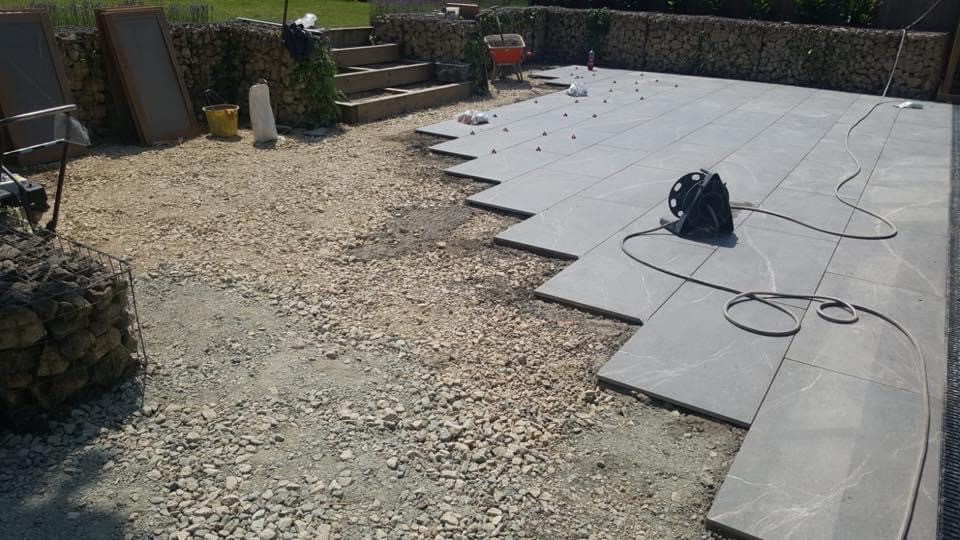What is Slurry Primer — Do You Need it?

The Importance of Slurry Primer When Installing Porcelain Paving
Installing porcelain paving is slightly different from laying other types of paving materials due to its non-porous nature. That’s where slurry primer comes in—a crucial step to ensure your porcelain tiles stay firmly in place for years to come.
What is Slurry Primer?
Slurry primer is a specially formulated bonding agent that creates a strong adhesion between your porcelain tile and the mortar bed beneath. Unlike traditional paving stones such as sandstone or limestone, porcelain is non-porous, which means it won’t naturally grip onto the mortar without help.
To avoid loose tiles and potential patio problems down the line, slurry primer should always be applied to the underside of each porcelain tile before it’s laid onto the wet mortar bed. This wet-on-wet bond ensures that the mortar sticks to the primer, and the primer sticks to the tile—creating a secure, long-lasting fit.
Why Slurry Primer is Essential for Porcelain Paving
Porcelain paving is known for being:
-
✅ Stain-resistant
-
✅ Low maintenance
-
✅ Highly durable
-
✅ Anti-slip rated
However, due to its very low water absorption, porcelain won’t bond effectively using traditional methods. That’s why using a quality slurry primer is critical. It prevents lifting, cracking, and movement—protecting your investment and giving your patio the strength it needs to handle changing UK weather.
Even experienced landscapers recommend it as standard practice—not just for porcelain, but increasingly for natural stone paving as well.
How to Use Slurry Primer
Using slurry primer is simple:
-
Brush or trowel the slurry primer onto the entire underside of each porcelain slab.
-
Lay the tile onto a full, wet mortar bed (never dry).
-
Make sure there are no voids under the slab—this gives your paving the best chance of long-term durability.
Types of Slurry Primer:
-
Self-Mix Slurry Primer: A powdered mix you add water to. Use a paddle or drill whisk to mix to a smooth paste.
-
Pre-Mixed Slurry Primer: Ready to use straight from the tub—no mixing required.
Both options are highly effective when applied correctly. Just make sure you use enough to fully cover the underside of the tile.
Can You Make Your Own Slurry Primer?
We don’t recommend it.
Some people attempt to make DIY slurry primer using SBR and cement, but these homemade mixes don’t contain the specialist binding fibres that professionally formulated primers include. Without these fibres, the bond between mortar and porcelain isn’t nearly as strong—and over time, that means loose, shifting tiles.
At Discount Porcelain Superstore, we only stock high-quality slurry primer designed specifically for outdoor porcelain paving and natural stone. It’s an affordable addition that helps protect your patio from future issues and ensures peace of mind.
Why You Shouldn’t Lay Porcelain Directly onto a Wet Mortar Bed
Unlike natural stone, porcelain paving will not bond properly if laid directly onto mortar without a primer. The result? Tiles that lift, crack, or come loose over time.
To ensure a flawless installation:
-
✅ Always use a wet slurry primer on a wet mortar bed
-
✅ Cover the entire underside of the tile
-
✅ Use a full bed of mortar (no spot-fixing)
-
✅ Avoid voids underneath the slab
This method ensures a robust, reliable finish—and avoids the need for future repairs.
Where to Buy Slurry Primer and Porcelain Paving
At Discount Porcelain Superstore, we supply high-quality slurry primer, porcelain paving, and natural stone products for all your landscaping needs. We deliver nationwide, and our expert team is always here to offer guidance and support with your project.
Whether you're a DIY homeowner or a professional landscaper, we’ve got the materials—and the know-how—you need to get it done right.
???? Need help? Contact our expert team today.

